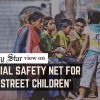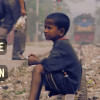Take homeless children off the streets and into care

The latest statistic from Unicef—that over 3.4 million children in Bangladesh are living on the streets without parental care—is both shocking and deeply concerning. It is common knowledge that these children are not only deprived of food, education, healthcare, and shelter, but also vulnerable to abuse and exploitation. Without any communal and familial support to lean on, they mostly end up in hazardous jobs such as construction, garbage collection, etc. Many fall prey to begging syndicates or drug traffickers; and some even develop an addiction to drugs. All this casts a long shadow over the future of these children and, by extension, the country.
True, the government has made considerable strides in reducing extreme poverty over the years, but it is clear that much more needs to be done, especially in terms of alleviating the woes of homeless children. One area where urgent attention is required is education as, according to a survey from last year, four out of every 10 street children have never been in school, while over 56.6 percent of those who attend school are unable to finish class 5.
The situation for girl children is more precarious. As well as reduced life prospects because of lack of schooling, they also face various health risks and are particularly vulnerable to early marriage, sexual abuse and exploitation. Unless these children are helped off the streets and properly rehabilitated, Bangladesh cannot attain true development, nor can it meet multiple Sustainable Development Goals. And the government's dream of building a Smart Bangladesh will remain unfulfilled if this situation persists.
A myriad of factors contribute to so many children being homeless and without parental care. But one common theme connecting them all is their inherent vulnerability. So the authorities must display foresight in their approach to helping them. There must be collaborative efforts among the government, non-government organisations, and community groups to discover sustainable solutions that will ensure the rights and well-being of all street children. We must aim to significantly reduce their number as soon as possible.


 For all latest news, follow The Daily Star's Google News channel.
For all latest news, follow The Daily Star's Google News channel. 










Comments